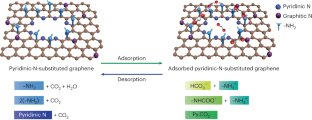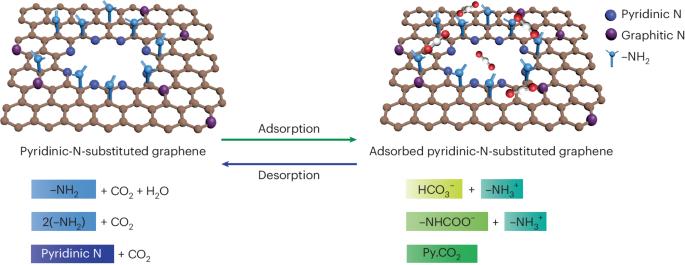孔隙边缘含有吡啶氮的石墨烯膜用于高性能二氧化碳捕获
IF 49.7
1区 材料科学
Q1 ENERGY & FUELS
引用次数: 0
摘要
基于多孔二维选择层的膜有可能实现优异的性能,从而提高能源效率并降低碳捕获成本。迄今为止,二维孔隙分离利用的是分子质量或大小的差异。然而,具有高渗透性和高选择性的二氧化碳竞争性吸附技术仍未问世。在这里,我们展示了室温下氨气与氧化单层石墨烯的简单接触会在孔隙边缘结合吡啶氮。这导致二氧化碳与孔隙高度竞争性但定量可逆地结合。从含有 20 Vol% CO2 的气流中分离出的 CO2/N2 分离因子(平均值为 53)和 CO2 渗透率(平均值为 10,420)的组合非常有吸引力。稀释(约 1 Vol%)二氧化碳流的分离系数超过了 1,000,这使得该膜有望从各种点排放源中捕获碳。由于采用了均匀且可扩展的化学方法,高性能厘米级膜得以展示。高性能二维膜的可扩展制备开辟了膜科学的新方向。本文章由计算机程序翻译,如有差异,请以英文原文为准。


Graphene membranes with pyridinic nitrogen at pore edges for high-performance CO2 capture
Membranes based on a porous two-dimensional selective layer offer the potential to achieve exceptional performance to improve energy efficiency and reduce the cost for carbon capture. So far, separation from two-dimensional pores has exploited differences in molecular mass or size. However, competitive sorption of CO2 with the potential to yield high permeance and selectivity has remained elusive. Here we show that a simple exposure of ammonia to oxidized single-layer graphene at room temperature incorporates pyridinic nitrogen at the pore edges. This leads to a highly competitive but quantitatively reversible binding of CO2 with the pore. An attractive combination of CO2/N2 separation factor (average of 53) and CO2 permeance (average of 10,420) from a stream containing 20 vol% CO2 is obtained. Separation factors above 1,000 are achieved for dilute (~1 vol%) CO2 stream, making the membrane promising for carbon capture from diverse point emission sources. Thanks to the uniform and scalable chemistry, high-performance centimetre-scale membranes are demonstrated. The scalable preparation of high-performance two-dimensional membranes opens new directions in membrane science. Graphene-based membranes are attractive for capturing CO2, with separation selectivity typically achieved by control of pore size. Here Hsu et al. incorporate pyridinic nitrogen species at the pore edges in graphene, leading to competitive CO2 binding and enhanced separation performance.
求助全文
通过发布文献求助,成功后即可免费获取论文全文。
去求助
来源期刊

Nature Energy
Energy-Energy Engineering and Power Technology
CiteScore
75.10
自引率
1.10%
发文量
193
期刊介绍:
Nature Energy is a monthly, online-only journal committed to showcasing the most impactful research on energy, covering everything from its generation and distribution to the societal implications of energy technologies and policies.
With a focus on exploring all facets of the ongoing energy discourse, Nature Energy delves into topics such as energy generation, storage, distribution, management, and the societal impacts of energy technologies and policies. Emphasizing studies that push the boundaries of knowledge and contribute to the development of next-generation solutions, the journal serves as a platform for the exchange of ideas among stakeholders at the forefront of the energy sector.
Maintaining the hallmark standards of the Nature brand, Nature Energy boasts a dedicated team of professional editors, a rigorous peer-review process, meticulous copy-editing and production, rapid publication times, and editorial independence.
In addition to original research articles, Nature Energy also publishes a range of content types, including Comments, Perspectives, Reviews, News & Views, Features, and Correspondence, covering a diverse array of disciplines relevant to the field of energy.
 求助内容:
求助内容: 应助结果提醒方式:
应助结果提醒方式:


